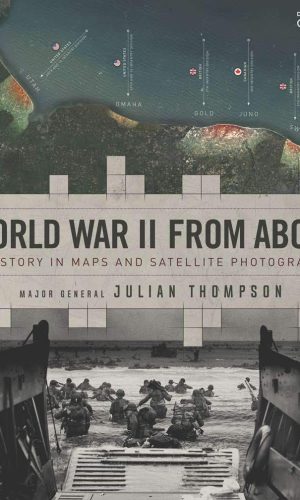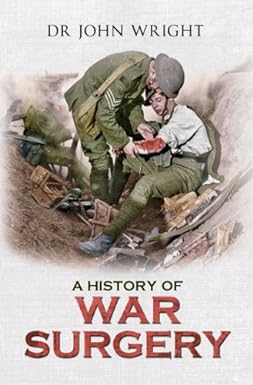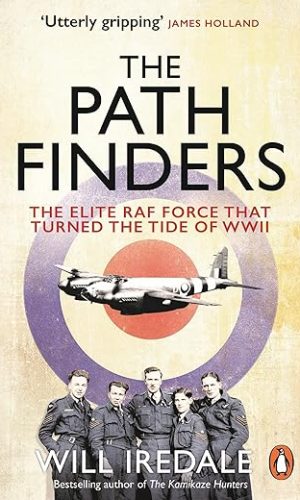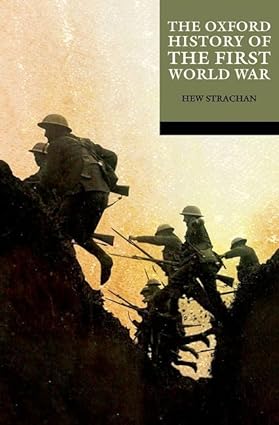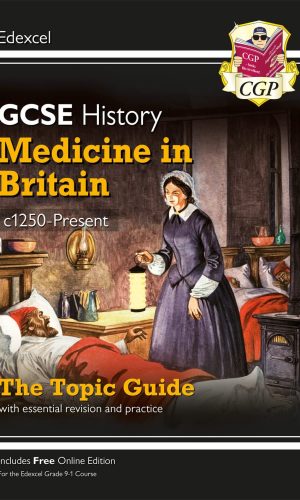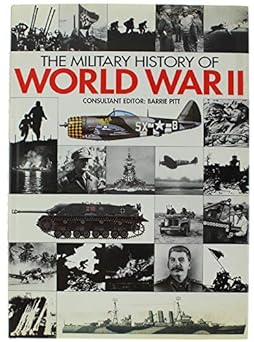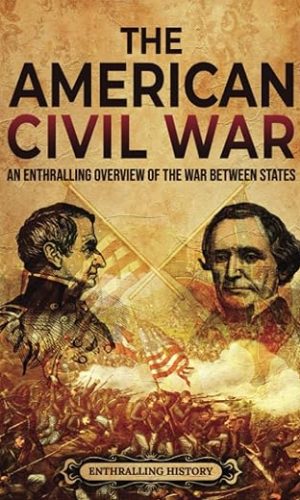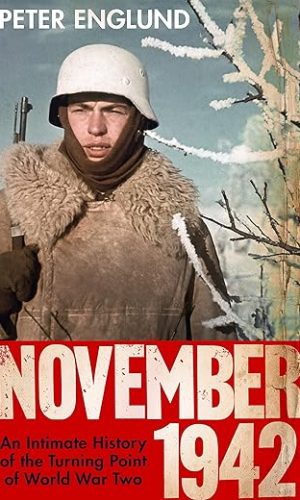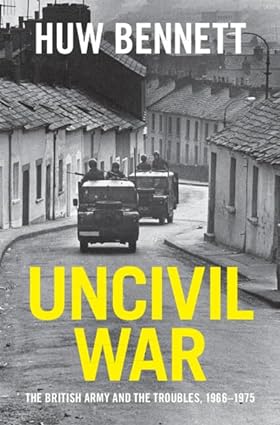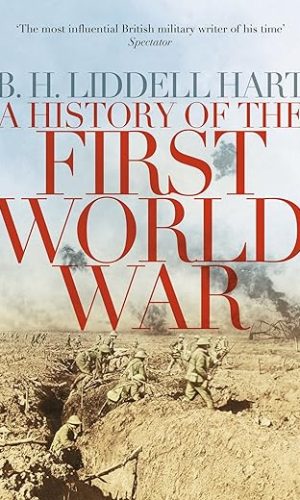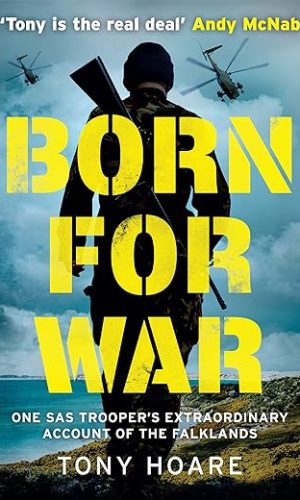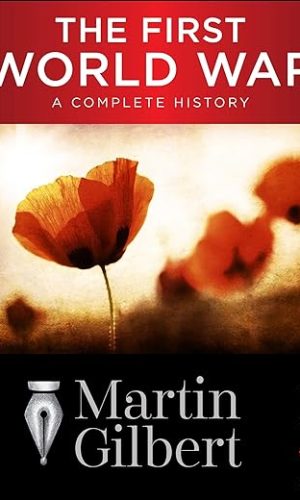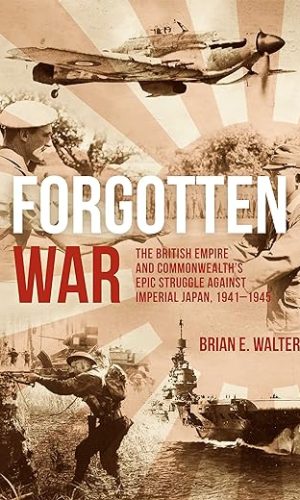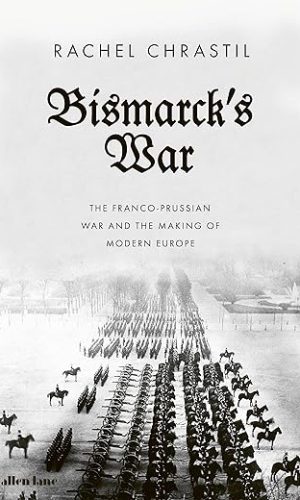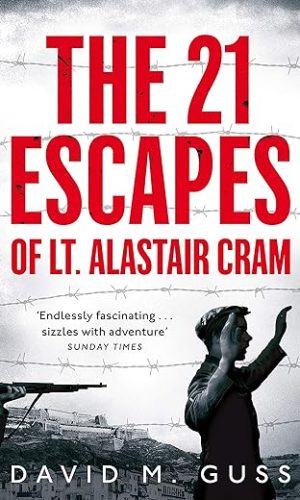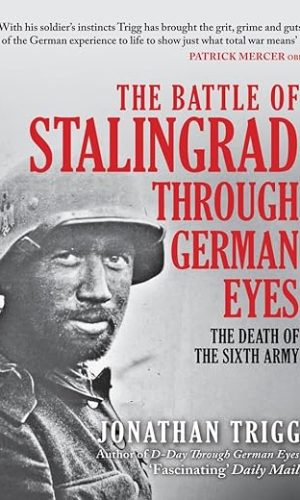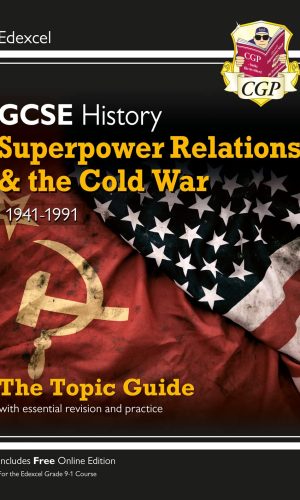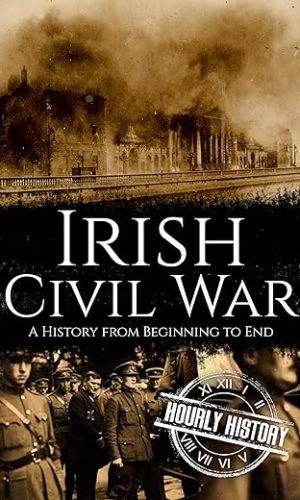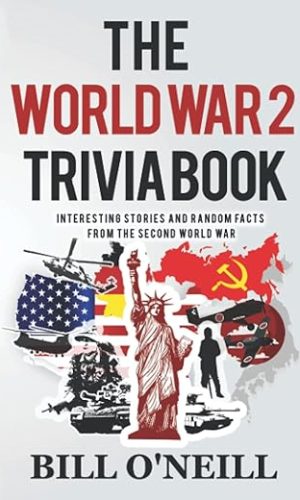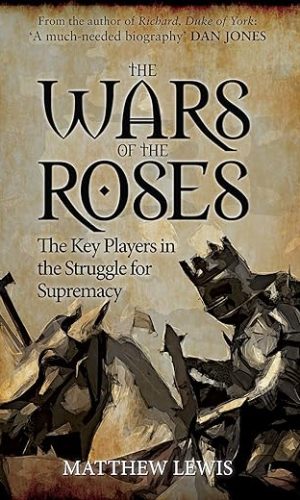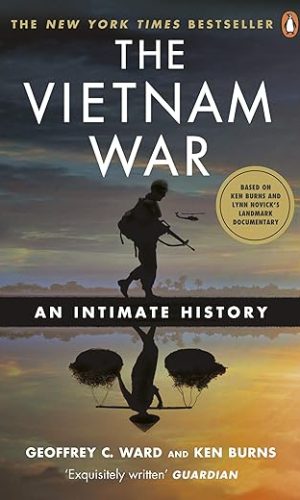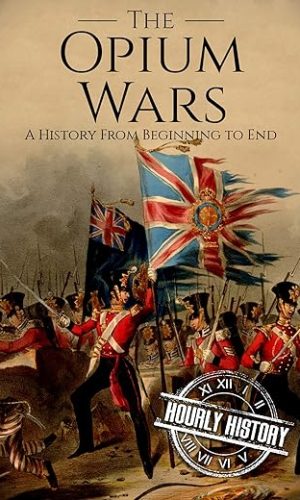-
World War II from Above: A History in Maps and Satellite Photographs
World War II from Above offers a never-before-seen combination of annotated satellite images and expertly drawn battle maps. It aims to satisfy both the military history buff and those seeking a visually stunning history gift book, bringing the war vividly and dramatically to life by showing the actual landscapes where battles took place along with specially commissioned annotations depicting remarkable events, troop movements, heroic last stands, or even where individual soldiers stood or fell.
Each of the 25 chapters features an enhanced Google Earth image, along with specially commissioned battle maps showing every facet of the conflict in exceptional detail.
Here you will find all the key milestones of World War II: the invasion of France, Germany’s first blitzkrieg offensives, the Battle of Alamein, Monte Cassino, Arnhem, the invasion of Sicily, the Battle of the Bulge, Iwo Jima, D-Day and the final push to Berlin, along with a host of other strategic and battle maps from every geographical location.
Written by a highly decorated soldier and leading military history expert, this is an innovative, richly detailed and visually stunning overview of history’s most destructive conflict.
Read more
£16.50£19.00 -
A History of War Surgery
Since antiquity, war surgery has been a profession demanding a special kind of human: one able to face seemingly insurmountable problems; one able to keep a lucid mind and steady hands in extraordinary circumstances; one able to shoulder tremendous burdens; and one able to harden himself or herself, time and again, to failure and self-doubt. It is, and always has been, a harrowing business, and only for the brave. Dr John Wright charts the evolution of war surgery from ancient times to the present day, investigating its breakthroughs, its pitfalls, and the people and conflicts that have shaped it. But above all, this is a personal history, calling on the first-hand accounts of the surgeons, soldiers, medics, nurses, stretcher-bearers, and many others who have served in battle and come face-to-face with its most appalling horrors. This is not a book for the faint-hearted. It is one that searches for and delivers the truth about those who, with unerring skill, courage and determination, endeavour to undo the terrible damage we habitually inflict upon ourselves.Read more
£7.30A History of War Surgery
£7.30 -
Anglo-Saxon Kings and Warlords AD 400–1070: 253 (Elite)
Richly illustrated, this title describes Anglo-Saxon monarchs, warlords and their warriors and households in Anglo-Saxon Britain, from the first post-Roman mercenaries to the Norman Conquest.In a country fragmented by Roman withdrawal during the 5th century AD, the employment of Germanic mercenaries by local rulers in Anglo-Saxon Britain was commonplace. These mercenaries became settlers, forcing Romano-British communities into Wales and the West Country. Against a background of spreading Christianity, the struggles of rival British and Anglo-Saxon kingdoms were exploited by the Vikings, but eventually contained by the Anglo-Saxon king, Alfred of Wessex. His descendants unified the country during the 10th century, however, subsequent weak rule saw its 25-year incorporation into a Danish empire before it finally fell to the Norman invasion of 1066.
Scholars of the early Church have long known that the term ‘Dark Ages’ for the 5th to 11th centuries in Britain refers only to a lack of written sources, and gives a false impression of material culture. The Anglo-Saxon warrior elite were equipped with magnificent armour, influenced by the cultures of the late Romans, the Scandinavian Vendel people, the Frankish Merovingians, Carolingians and Ottonians, and also the Vikings.
In this volume, co-authors Raffaele D’Amato and Stephen Pollington access their extended knowledge to paint a vivid picture of the kings and warlords of the time with the aid of colour illustrations, rare photos and the latest archaeological research.
Read more
£10.40£14.20 -
The World War II Collection
A wonderful gift for any military history enthusiast.
This collection not only covers notable battles but also life under the Nazi regime and the trials that bought the regime’s figureheads to justice.
This handsome box set brings together five titles which recount the major events of World War II, from Dunkirk to the Nuremberg trials. With breakdowns of skillful military manoeuvres, chilling accounts of Nazi organizations and astounding details from the fall of Berlin, this collection chronicles the defeat of Germany and the Axis powers.
These titles are:
• Great Battles of World War II by Michael Dudley
• The D-Day Landings by Nigel Cawthorne
• Hitler’s Last Day by Richard Dargie
• The Story of the SS by Al Cimino
• The Nuremberg Trials by Alexander MacdonaldA great read for both military history enthusiasts and those eager to learn more about World War II.
Read more
£18.00The World War II Collection
£18.00 -
The Pathfinders: The Elite RAF Force that Turned the Tide of WWII
THE SUNDAY TIMES BESTSELLER!
Military History Matters Book of the Year Bronze Award Winner
‘Compelling… sensitive, colourful and moving’ — Saul David, Telegraph
‘Fascinating and utterly gripping’ — James Holland
‘Absorbing’ — Daily Mail Book of the WeekThe incredible story of the crack team of men and women who transformed RAF Bomber Command and helped the Allies deliver decisive victory over Nazi Germany.
The Pathfinders were ordinary men and women from a range of nations who revolutionised the efficiency of the Allies’ air campaign over mainland Europe. They elevated Bomber Command – initially the only part of the Allied war effort capable of attacking the heart of Nazi Germany – from an impotent force on the cusp of disintegration in 1942 to one capable of razing whole German cities to the ground in a single night, striking with devastating accuracy, inspiring fear and loathing in Hitler’s senior command.
With exclusive interviews with remaining survivors, personal diaries, previously classified records and never-before seen photographs, The Pathfinders brings to life the characters of the airmen and women – many barely out of their teens – who took to the skies in legendary British aircraft such as the Lancaster and the Mosquito, facing almost unimaginable levels of violence from enemy fighter planes to strike at the heart of the Nazi war machine.
Read more
£11.10£12.30 -
Zulu
Saul David’s Zulu: The Heroism and Tragedy of the Zulu War of 1879 is a fascinating look at the most controversial and brutal British imperial conflict of the nineteenth century.
The real story of the Anglo-Zulu war was one of deception, dishonour, incompetence and dereliction of duty by Lord Chelmsford who invaded Zululand without the knowledge of the British Government. But it did not go to plan and there were many political repercussions. Using new material from archives in Britain and South Africa, Saul David blows the lid on this most sordid of imperial wars and comes to a number of startling new conclusions.
‘Saul David’s brilliant and magisterial account must now be regarded as the definitive history of the Zulu War’ Frank McLynn, Literary Review
‘This meticulously detailed book…give[s] a fully rounded and judicious account of this dismal conflict Guardian
‘Fascinating, thrilling, convincing… reads like a novel’ Economist
Saul David is Professor of War Studies at the University of Buckingham and the author of several critically acclaimed history books, including The Indian Mutiny: 1857 (shortlisted for the Westminster Medal for Military Literature), Zulu: The Heroism and Tragedy of the Zulu War of 1879 (a Waterstone’s Military History Book of the Year) and, most recently, Victoria’s Wars: The Rise of Empire.
Read more
£5.40£12.30Zulu
£5.40£12.30 -
The Oxford History of the First World War
bHistories you can trust./bThe First World War, now a century ago, still shapes the world in which we live, and its legacy lives on, in poetry, in prose, in collective memory and political culture. By the time the war ended in 1918, millions lay dead. Three major empires lay shattered by defeat, those of Germany, Austria-Hungary, and the Ottomans. A fourth, Russia, was in the throes of a revolution that helped define the rest of the twentieth century.
The Oxford History of the First World War brings together in one volume many of the most distinguished historians of the conflict, in an account that matches the scale of the events. From its causes to its consequences, from the Western Front to the Eastern, from the strategy of the politicians to the tactics of the generals, they chart the course of the war and assess its profound political and human consequences. Chapters on economic mobilization, the impact on women, the role of propaganda, and the rise of socialism establish the wider context of the fighting at sea and in the air, and which ranged on land from the trenches of Flanders to the mountains of the Balkans and the deserts of the Middle East.
Read more
£11.20£12.30The Oxford History of the First World War
£11.20£12.30 -
GCSE History Edexcel Topic Guide – Medicine in Britain, c1250-Present: for the 2024 and 2025 exams (CGP Edexcel GCSE History)
Perfect for achieving the best grades in 2024 and 2025. From CGP ― the GCSE experts!
There’s no better way to learn everything for Edexcel 9-1 GCSE History – Medicine in Britain (c1250-present) than with this unbeatable CGP Topic Guide. It’s packed with crystal-clear revision notes and heaps of activities. There are exam-style questions to test students understanding of the topic and the skills they’ll need for the Thematic Study and Historic Environment section of the exam – as well as practice using sources for the Historic Environment section of the exam. Our handy worked answers and advice mean students can walk into the exam feeling confident they know what good answers look like. Plus there are exam tips throughout the book and answers at the back.
Read more
£6.20 -
Conflict and Tension between East and West 1945-1972 Revision Guide: Get Revision with Results (Oxford AQA GCSE History)
This Conflict and Tension between East and West 1945-1972 Revision Guide is part of the popular Oxford AQA GCSE History (9-1) series. Written by our original author team to match the new AQA specification, this guide covers exactly what your students require to succeed in the Paper 1 Conflict and Tension between East and West Wider World Depth Study exams.
– Recap key events of the Cold War with clear visual diagrams and brief points
– Apply knowledge with targeted revision activities that tests basic comprehension, then apply understanding towards exam-style questions
– Review and track revision with progress checklists, suggested activity answers and Exam Practice sections
– Step-by-step exam guidance based on the popular ‘How to’ student book feature
– Examiner Tip features most up-to-date expert advice and identifies common exam mistakes
– Boost student confidence on all AQA GCSE Conflict and Tension question types with revision activities such as Source Analysis and How Far Do You Agree
– Perfect for use alongside the Student Book and Kerboodle, or as a stand-alone resource for independent revision.
This revision guide helps your students Recap, Apply, and Review their way towards exam success.Read more
£7.40 -
The Military History of World War II
Traces the origins and course of World War II across the globe, from the invasion of Poland to the destruction of Hiroshima. The book includes numerous contemporary photographs, as well as features and maps on particular aspects of the conflict and the military hardware used by both sides.Read more
£0.40 -
St Helens Pals War Diary
The Great War Diary of the St Helens Pals, the 11th Battalion South Lancashire Regiment, following their journey through France and Flanders from 1914 to 1918.Read more
£7.60St Helens Pals War Diary
£7.60 -
The Battle of the Beams: The secret science of radar that turned the tide of the Second World War
‘Deeply researched and engagingly written’ The Times
‘Has the pace and style of a well-crafted thriller’ Mail on Sunday
‘Chock full of memorable characters and written with all the drama and pace of a Robert Harris thriller’ Rowland White, author of Harrier 809The radio war of 1939-45 is one of the great scientific battles in history.
This is the story of that war.Relying on first-hand accounts as well as papers recently released by the Admiralty, The Battle of the Beams fills a huge missing piece in the canon of WW2 literature.
It combines history, science, derring do and dogged determination and will appeal as much to fans of WW2 history as to those fascinated by the science behind the beams that changed our lives.
The British believed that, through ingenuity and scientific prowess, they alone have a war-winning weapon: radar. They are wrong. The Germans have it too.
They believe that their unique maritime history means their pilots have no need of navigational aids. Flying above the clouds they, like the seafarers of old, had the stars to guide them, and that is all that is required. They are wrong. Most of the bombs the RAF will drop in the first years of the war land miles from their target.
They also believe that the Germans, without the same naval tradition, will never be able to find targets at night. They are, again, wrong. In 1939 the Germans don’t just have radar to spot planes entering their airspace, they have radio beams to guide their own planes into enemy airspace.
Luckily there was one young engineer, Reginald Jones, helping the British government with their own scientific developments. In June 1940, when Jones quietly explained the beams the Germans had devised to a room full of disbelieving sceptics, Churchill later described the moment as like sitting in the parlour while Sherlock Holmes finally reveals the killer. Churchill immediately supported Jones’s efforts to develop radar technology that went on to help the Allies win the war.
Read more
£15.20£19.00 -
Short History of War
A wonderfully engaging, accessible introduction to war, from ancient times to the present and into the futureThroughout history, warfare has transformed social, political, cultural, and religious aspects of our lives. We tell tales of wars—past, present, and future—to create and reinforce a common purpose.
In this engaging overview, Jeremy Black examines war as a global phenomenon, looking at the First and Second World Wars as well as those ranging from Han China and Assyria, Imperial Rome, and Napoleonic France to Vietnam and Afghanistan. Black explores too the significance of warfare more broadly and the ways in which cultural understandings of conflict have lasting consequences in societies across the world. Weaponry, Black argues, has had a fundamental impact on modes of war: it created war in the air and transformed it at sea. Today, as twentieth-century weapons are challenged by drones and robotics, Black examines what the future of warfare looks like.Read more
£7.60£14.20Short History of War
£7.60£14.20 -
The American Civil War: An Enthralling Overview of the War Between States (U.S. History)
A nation divided, a war between brothers, and immense political and social consequences—the American Civil War is certainly one of the most famous conflicts in world history.Everyone has heard of the bloody conflict that cost the lives of over one million people. When people think of the Civil War, they think of Abraham Lincoln, the Emancipation Proclamation, and the North-South divide between the American states, but there is so much more to uncover about the American Civil War.
This book will dive into the details of the Civil War and explore what caused it, how it unfolded, and its short- and long-term consequences.
You will discover the following in this book:
- The socio-political situation of 19th-century America before the war
- Roots of the problem of slavery
- Abraham Lincoln and the creation of the Republican Party
- The infamous North-South divide
- Causes of secession and the beginning of the war
- Main actors on both sides, including Ulysses S. Grant, Jefferson Davis, and Robert E. Lee
- Military campaigns that shaped the four-year-long war
- The influential battles of Gettysburg, Chancellorsville, Vicksburg, and Fredericksburg
- The passing of the Emancipation Proclamation
- The assassination of President Lincoln
- Reforms and policies of post-war United States
- And much, much more!
Scroll up and click the “add to cart” button to begin unpacking the history of the US Civil War!
Read more
£10.50 -
November 1942: An Intimate History of the Turning Point of the Second World War
**A Telegraph Best History Book of 2023**
‘An astonishing achievement’ ANTONY BEEVOR
‘Extraordinary’ JULIA BOYDAn intimate history of the most important month of the Second World War – perhaps the century – as experienced by those who lived through it, completely based on their diaries, letters and memoirs.
At the beginning of November 1942, it looked as if the Axis powers could win the war; at the end of that month, it was obviously just a matter of time before they would lose.
In between came el-Alamein, Guadalcanal, the French North Africa landings, the Japanese retreat in New Guinea, and the Soviet encirclement of the German 6th Army at Stalingrad. In this innovatively kaleidoscopic and riveting historical marvel, Peter Englund reduces these epoch-making events to their basic component: the individual experience.
In thirty memorable days we meet characters including a Soviet infantryman at Stalingrad; an Italian truck driver in the North African desert; a partisan in the Belarussian forests; a machine gunner in a British bomber; a twelve-year-old girl in Shanghai; a university student in Paris; a housewife on Long Island; a prisoner in Treblinka; Albert Camus, Vasily Grossman, and Vera Brittain – forty characters in all. We also witness the launch of SS James Oglethorpe; the fate of U-604, a German submarine; the building of the first nuclear reactor; and the making of Casablanca.
Not since Englund’s own The Beauty and the Sorrow has a book given us one of the most dramatic periods of human history in all its immensity and emotional range.
‘Thought-provoking’ SUNDAY TIMES
‘Thoroughly worth reading’ TELEGRAPHRead more
£19.80£23.80 -
Uncivil War: The British Army and the Troubles, 1966–1975 (Cambridge Military Histories)
When Operation Banner was launched in 1969 civil war threatened to break out in Northern Ireland and spread over the Irish Sea. Uncivil War reveals the full story of how the British army acted to save Great Britain from disaster during the most violent phase of the Troubles but, in so doing, condemned the people of Northern Ireland to protracted, grinding conflict. Huw Bennett shows how the army’s ambivalent response to loyalist violence undermined the prospects for peace and heightened Catholic distrust in the state. British strategy consistently underestimated community defence as a reason for people joining or supporting the IRA whilst senior commanders allowed the army to turn in on itself, hardening soldiers to the suffering of ordinary people. By 1975 military strategists considered the conflict unresolvable: the army could not convince Catholics or Protestants that it was there to protect them and settled instead for an unending war.Read more
£19.00£23.80 -
Civil War: The History of England Volume III (The History of England, 3)
In Civil War, Peter Ackroyd continues his dazzling account of England’s history, beginning with the progress south of the Scottish king, James VI, who on the death of Elizabeth I became the first Stuart king of England, and ends with the deposition and flight into exile of his grandson, James II.
The Stuart dynasty brought together the two nations of England and Scotland into one realm, albeit a realm still marked by political divisions that echo to this day. More importantly, perhaps, the Stuart era was marked by the cruel depredations of civil war, and the killing of a king.
Ackroyd paints a vivid portrait of James I and his heirs. Shrewd and opinionated, the new King was eloquent on matters as diverse as theology, witchcraft and the abuses of tobacco, but his attitude to the English parliament sowed the seeds of the division that would split the country in the reign of his hapless heir, Charles I. Ackroyd offers a brilliant – warts and all – portrayal of Charles’s nemesis Oliver Cromwell, Parliament’s great military leader and England’s only dictator, who began his career as a political liberator but ended it as much of a despot as ‘that man of blood’, the king he executed.
England’s turbulent seventeenth century is vividly laid out before us, but so too is the cultural and social life of the period, notable for its extraordinarily rich literature, including Shakespeare’s late masterpieces, Jacobean tragedy, the poetry of John Donne and Milton and Thomas Hobbes’ great philosophical treatise, Leviathan. Civil War also gives us a very real sense of the lives of ordinary English men and women, lived out against a backdrop of constant disruption and uncertainty.
Read more
£13.60£16.10 -
A History of the First World War
Liddell Hart’s History of the First World War first appeared in 1930 and is widely regarded as one of the greatest, most cogent accounts of the conflict ever published.
A leading military strategist and historian who fought on the Western Front, Liddell Hart combines astute tactical analysis with compassion for those who lost their lives on the battlefield. He provides a vivid and fascinating picture of all the major campaigns, balancing documentary evidence with the testimony of personal witnesses to expose the mistakes that were made and why.
From the political and cultural origins of war to the twists and turns of battle, to the critical decisions that resulted in such devastating losses and to the impact on modern nations, this magnificent history covers four brutal years in one volume and is a true military classic.
Read more
£13.60£16.10A History of the First World War
£13.60£16.10 -
Napoleon’s Wars: An International History, 1803-1815
No other soldier has provoked as much anger or as much fervour as Napoleon Bonaparte. Was he a monster, driven on by an endless, ruinous quest for military adventure – or was he a social and political visionary, brought down by petty reactionaries clinging to their privileges?
Charles Esdaile’s major new work reframes our understanding of Napoleon. Napoleon’s Wars looks beyond the insatiable greed for glory to create a new, genuinely international context for Napoleon’s career. The battles themselves Esdaile sees as almost side-effects, the consequences of rulers being willing to take the immense risks of fighting or supporting Napoleon – risks that could result in the extinction of entire countries and regimes.
Read more
£13.60£16.10Napoleon’s Wars: An International History, 1803-1815
£13.60£16.10 -
Born For War: One SAS Trooper’s Extraordinary Account of the Falklands
‘A no holdout account of the Falklands War from a man who was in the fight.’ Andy McNab
Tony Hoare always knew he wanted to be in the SAS and so, after working his way through the ranks, he passed arduous SAS selection in 1978.
Less than four years later, Tony and his team were sent to the Falklands, just off the coast of Argentina, where tensions were rising and war was on the horizon. Nothing could have prepared him for what happened over the course of the next 12 weeks, as the Falkland Islands became a battleground between the British and Argentinians. As helicopters crashed and ships sank, Tony battled across treacherous terrain to help reclaim the islands from a fearsome enemy.
This is a thrilling account of the Falklands from a trooper who saw it all.
Read more
£8.70£9.50 -
The First World War: A Complete History
“A stunning achievement of research and storytelling” that weaves together the major fronts of WWI into a single, sweeping narrative (Publishers Weekly, starred review).
It was to be the war to end all wars, and it began at 11:15 on the morning of June 28, 1914, in an outpost of the Austro-Hungarian Empire called Sarajevo. It would officially end nearly five years later. Unofficially, however, it has never ended: Many of the horrors we live with today are rooted in the First World War.
The Great War left millions of civilians and soldiers maimed or dead. It also saw the creation of new technologies of destruction: tanks, planes, and submarines; machine guns and field artillery; poison gas and chemical warfare. It introduced U-boat packs and strategic bombing, unrestricted war on civilians and mistreatment of prisoners. But the war changed our world in far more fundamental ways than these.
In its wake, empires toppled, monarchies fell, and whole populations lost their national identities. As political systems and geographic boundaries were realigned, the social order shifted seismically. Manners and cultural norms; literature and the arts; education and class distinctions; all underwent a vast sea change.
As historian Martin Gilbert demonstrates in this “majestic opus” of historical synthesis, the twentieth century can be said to have been born on that fateful morning in June of 1914 (Publishers Weekly, starred review).
“One of the first books that anyone should read . . . to try to understand this war and this century.” —The New York Times Book Review
Read more
£13.30 -
Hitler’s Soldiers: The German Army in the Third Reich
A penetrating study of the German army’s military campaigns, relations with the Nazi regime, and complicity in Nazi crimes across occupied EuropeFor decades after 1945, it was generally believed that the German army, professional and morally decent, had largely stood apart from the SS, Gestapo, and other corps of the Nazi machine. Ben Shepherd draws on a wealth of primary sources and recent scholarship to convey a much darker, more complex picture. For the first time, the German army is examined throughout the Second World War, across all combat theaters and occupied regions, and from multiple perspectives: its battle performance, social composition, relationship with the Nazi state, and involvement in war crimes and military occupation.
This was a true people’s army, drawn from across German society and reflecting that society as it existed under the Nazis. Without the army and its conquests abroad, Shepherd explains, the Nazi regime could not have perpetrated its crimes against Jews, prisoners of war, and civilians in occupied countries. The author examines how the army was complicit in these crimes and why some soldiers, units, and higher commands were more complicit than others. Shepherd also reveals the reasons for the army’s early battlefield successes and its mounting defeats up to 1945, the latter due not only to Allied superiority and Hitler’s mismanagement as commander-in-chief, but also to the failings―moral, political, economic, strategic, and operational―of the army’s own leadership.Read more
£12.30 -
Forgotten War: The British Empire and Commonwealth’s Epic Struggle Against Imperial Japan, 1941–1945
The monumental struggle fought against Imperial Japan in the Asia/Pacific theater during World War II is primarily viewed as an American affair. While the United States did play a dominant role, the British and Commonwealth forces also made major contributions – on land, at sea and in the air – eventually involving over a million men and vast armadas of ships and aircraft. It was a difficult and often desperate conflict fought against a skilled and ruthless enemy that initially saw the British suffer the worst series of defeats ever to befall their armed forces. Still, the British persevered and slowly turned the tables on their Japanese antagonists. Fighting over an immense area that stretched from India in the west to the Solomon Islands in the east and Australia in the south to the waters off Japan in the north, British and Commonwealth forces eventually scored a string of stirring victories that avenged their earlier defeats and helped facilitate the demise of the Japanese Empire.Often overlooked by history, this substantial war effort is fully explored in Forgotten War. Meticulously researched, the book provides a complete, balanced and detailed account of the role that British and Commonwealth forces played on land, sea and in the air during this crucial struggle. It also provides unique analysis regarding the effectiveness and relevance of this collective effort and the contributions it made to the overall Allied victory.
Read more
£20.10£23.80 -
The Big Book of History Crosswords: 51 Themed Crossword Puzzles and Fun Facts for History Lovers
Think you know your history? This bumper collection of 51 fun, fiendish crossword puzzles will challenge your knowledge of everything from Ancient Rome to the Arab Spring, from the Aztecs to the internet, from the Stone Age to the Jazz Age, and from Timbuktu to outer space.
Spanning centuries and ranging across continents, each crossword has something for everyone – whether you’re a keen quizzer, fancy yourself as a history expert, or are just fascinated by our shared past. Test yourself on historic battles, ancient cultures, earth-shaking revolutions and amazing inventions; play against the clock, or just against yourself. Open up a whole world of historical discovery. Let’s get puzzling!
- Absorbing puzzles on a large 17×17 grid
- A wide variety of questions across 14 history themes
- Over 860 quiz-style clues
- Clues and crossword grid are conveniently on the same page for each puzzle
- Solutions provided at the back of the book
- Fun facts every 2 puzzles to teach you something interesting you didn’t know before!
- The perfect gift for adult history fans
- All puzzles are in British English
Get 19 FREE bonus crosswords with this book! As a thank you for purchasing this book, we are giving away 19 FREE crosswords in a printable format for you test your history knowledge on hundreds more clues. The download link is provided in the book.
Read more
£6.60 -
The German Invasions of France during the World Wars: The History of Germany’s Campaigns in World War I and World War II
World War I, also known in its time as the “Great War” or the “War to End all Wars”, was an unprecedented holocaust in terms of its sheer scale. Fought by men who hailed from all corners of the globe, it saw millions of soldiers do battle in brutal assaults of attrition which dragged on for months with little to no respite. Tens of millions of artillery shells and untold hundreds of millions of rifle and machine gun bullets were fired in a conflict that demonstrated man’s capacity to kill each other on a heretofore unprecedented scale, and as always, such a war brought about technological innovation at a rate that made the boom of the Industrial Revolution seem stagnant. The enduring image of World War I is of men stuck in muddy trenches, and of vast armies deadlocked in a fight neither could win. It was a war of barbed wire, poison gas, and horrific losses as officers led their troops on mass charges across No Man’s Land and into a hail of bullets.If trench warfare was an inevitability during the war, it is only because the events leading up to the First Battle of the Marne were quite different. The armies at the beginning of the war moved quickly through the land, but the First Battle of the Marne devolved into a bloody pitched battle that led to the construction of trenches after the Germans retreated, blocked in their pursuit of Paris. When the aftermath disintegrated into a war between trenches, some Germans thought they had the upper hand since they were occupying French territory, but with fewer soldiers than the combined Allied nations and fewer resources and supplies, it was possibly only a matter of time before they were ultimately defeated. The commander of the German armies, General Helmuth von Moltke, allegedly said to Kaiser Wilhelm II immediately after the First Battle of the Marne, “Your Majesty, we have lost the war.” Winston Churchill himself would later reference that anecdote, writing, “Whether General von Moltke actually said to the Emperor, ‘Majesty, we have lost the war,’ we do not know. We know anyhow that with a prescience greater in political than in military affairs, he wrote to his wife on the night of the 9th, ‘Things have not gone well. The fighting east of Paris has not gone in our favour, and we shall have to pay for the damage we have done.’”
One of the most famous people in the world came to tour the city of Paris for the first time on June 28, 1940. Over the next three hours, he rode through the city’s streets, stopping to tour L’Opéra Paris. He rode down the Champs-Élysées toward the Trocadero and the Eiffel Tower, where he had his picture taken. After passing through the Arc de Triomphe, he toured the Pantheon and old medieval churches, though he did not manage to see the Louvre or the Palace of Justice. Heading back to the airport, he told his staff, “It was the dream of my life to be permitted to see Paris. I cannot say how happy I am to have that dream fulfilled today.” Four years after his tour, Adolf Hitler would order the city’s garrison commander, General Dietrich von Choltitz, to destroy Paris, warning his subordinate that the city “must not fall into the enemy’s hand except lying in complete debris.”
Of course, Paris was not destroyed before the Allies liberated it, but it would take more than four years for them to wrest control of France from Nazi Germany after they took the country by storm in about a month in 1940. That said, it’s widely overlooked today given how history played out that as the power of Nazi Germany grew alarmingly during the 1930s, the French sought means to defend their territory against the rising menace of the Thousand-Year Reich. As architects of the most punitive measures in the Treaty of Versailles following World War I, France was a natural target for Teutonic retribution, so the Maginot Line, a series of interconnected strongpoints and fortifications running along much of France’s eastern border.
Read more
£4.70 -
Bismarck’s War: The Franco-Prussian War and the Making of Modern Europe
‘Compassionate and thought-provoking history’ Daily Telegraph
‘Superb on the human consequences of war, ravishing in its evocations of wartime life’ The Times
‘Fresh and compelling … a tour-de-force’ David A. Bell
Less than a month after it marched into France in summer 1870, the Prussian army had devastated its opponents, captured Napoleon III and wrecked all assumptions about Europe’s pecking order. Other countries looked on in helpless amazement. Pushing aside further French resistance, a new German Empire was proclaimed (as a deliberate humiliation) in the Palace of Versailles, leaving the French to face civil war in Paris, reparations and the loss of Alsace and Lorraine.
Bismarck’s War tells the story of one of the most shocking reversals of fortune in modern European history. The culmination of a globally violent decade, the Franco-Prussian War was deliberately engineered by Bismarck, both to destroy French power and to unite Germany. It could not have worked better, but it also had lurking inside it the poisonous seeds of all the disasters that would ravage the twentieth century.
Drawing on a remarkable variety of sources, Chrastil’s book explores the military, technological, political and social events of the war, its human cost and the way that the sheer ferocity of war, however successful, has profound consequences for both victors and victims.
Read more
£24.50£28.50 -
A Nasty Little War: The West’s Fight to Reverse the Russian Revolution
‘A vivid and sparkling account, full of colour and dark drama’ The Observer
‘Chillingly original’ Max Hastings, ‘Pick of the Week’, The Times
‘Brilliantly depicts a disastrous failure’ Antony Beevor
‘Witty and elegant . . . Excellent background to today’s events’ Anne Applebaum
‘Britain’s most forgotten war, brilliantly remembered’ Simon Jenkins
‘Vivid and remarkably timely’ Martin Sixsmith
From the bestselling author of Borderland: A Journey Through the History of Ukraine
The extraordinary story of how the West tried to reverse the Russian Revolution.
In the closing months of the First World War, Britain, America, France and Japan sent arms and 180,000 soldiers to Russia, with the aim of tipping the balance in her post-revolutionary Civil War. From Central Asia to the Arctic and from Poland to the Pacific, they joined anti-Bolshevik forces in trying to overthrow the new men in the Kremlin, in an astonishingly ambitious military adventure known as the Intervention.
Fresh, in the case of the British, from the trenches, they found themselves in a mobile, multi-sided conflict as different as possible from the grim stasis of the Western Front. Criss-crossing the shattered Russian empire in trains, sleds and paddlesteamers, they bivouacked in snowbound cabins and Kirghiz yurts, torpedoed Red battleships from speedboats, improvised new currencies and the world’s first air-dropped chemical weapons, got caught up in mass retreats and a typhus epidemic, organised several coups and at least one assassination. Taking tea with warlords and princesses, they also turned a blind eye to their Russian allies’ numerous atrocities.
Two years later they left again, filing glumly back onto their troopships as port after port fell to the Red Army. Later, American veterans compared the humiliation to Vietnam, and the politicians and generals responsible preferred to trivialise or forget. Drawing on previously unused diaries, letters and memoirs, A Nasty Little War brings an episode with echoes down the century since vividly to life.
Read more
£19.00£23.80 -
The 21 Escapes of Lt Alastair Cram: A Compelling Story of Courage and Endurance in the Second World War
A genuinely new Second World War story, The 21 Escapes of Lt Alastair Cram by David M. Guss is a riveting account of the wartime exploits of the Scotsman. It is a tale of courage in the face of extraordinary odds and a testament to one man’s dogged determination never to give up.
‘The greatest serial escaper of the Second World War’ – The Times
‘Endlessly fascinating. Cram’s story sizzles with adventure’ – Giles Milton, Sunday Times
In November 1941 Lt Alastair Cram was taken prisoner in North Africa as a devastating tank battle unfolded as Operation Crusader struggled to relieve Tobruk. His capture began a four year-long odyssey as he passed through twelve different POW camps, three Gestapo prisons and one asylum. Determined to regain his freedom, he became a serial escapee fleeing his captors no fewer than twenty-one times.
The most dramatic of these attempts was from Gavi, the ‘Italian Colditz’. This maximum-security prison built inside a thousand year old stone fortress was for the pericolosi, those classified as the ‘most dangerous’ prisoners due to their unrelenting desire to escape. It was here that Alastair met David Stirling, the legendary founder of the SAS, and cooked up the plan for the ‘Cistern Tunnel’, one of the most audacious but little-known mass escape attempts of the entire war.
______________‘Fascinating’ – Daily Express
‘An enthralling portrait of true courage’ Sunday Express S Magazine
Read more
£8.70£9.50 -
Revise Edexcel GCSE (9-1) History: Superpower Relations and the Cold War Revision Cards (with free online Revision Guide and Workbook): For 2024 and … and exams (Revise…
Exam Board: Edexcel
Level & Subject: GCSE History
First teaching: September 2016 First exams: June 2018REVISE Edexcel GCSE (9-1) History: Superpower Relations and the Cold War Revision Cards are perfect for students who want to turbocharge their revision time! Each pack includes access to a FREE online edition of the REVISE Edexcel GCSE (9-1) History: Superpower Relations and the Cold War Revision Guide and contains:
- 30 Revision Cards and three organising dividers (with a handy ‘how to use’ guide)
- Multiple choice questions and answers
- Worked examples
- Topic summaries and key facts to remember
Read more
£4.70 -
The Battle of Stalingrad Through German Eyes: The Death of the Sixth Army
Five months, one week and three days of hell. The German offensive to capture Stalingrad began in August 1942, using Friedrich Paulus’s 6th Army and elements of the 4th Panzer Army. The attack was supported by intense bombing that reduced much of the city to rubble. The battle degenerated into house-to-house fighting, as both sides fought for the city on the Volga. By mid-November, the Germans were on the brink of victory as the Soviet defenders clung on to a final few slivers of land along the west bank of the river. Then, on 19 November, the Red Army launched Operation Uranus, targeting the weaker Romanian armies protecting the 6th Army’s flanks. The ill-equipped Romanians were overrun and the 6th Army was cut off and surrounded. Hitler was determined to hold the city – the symbolic namesake of the Soviet leader – and forbade the 6th Army from attempting a breakout, insisting they be supplied by air instead; in February 1943, without food or ammunition, some 91,000 starving, lice-ridden Germans surrendered. The losses on both sides were eye-watering – the Soviets alone suffered something approaching half a million dead and more than 650,000 sick or wounded – and in his unique style author Jonathan Trigg reveals the human agony behind such statistics through the words of the Germans who were there. Was it all over after the surrender? Of course not. Death marches did for many: Landser Josef Farber remembered: ‘We set out with 1,200 men … about 120 were alive when we reached the camp.’ This was war at its rawest – this was Stalingrad.Read more
£16.70£19.00 -
The Times Second World War: The history of the global conflict from 1939 to 1945
The perfect gift for history fans.
Follow the conflict of World War 2 from 1939 to 1945 through a unique collection of historical maps, expert commentary and photographs. Published in association and including material from the archives of the Imperial War Museum, London.
Over 200 photographs and maps from the archives of The Imperial War Museum tell the story of how this global war was fought.
Descriptions of key historical events accompany the illustrations, giving a fascinating history of the war from an expert historian.
Key topics covered include
• 1939: Invasion of Poland
• 1940: German invasion of Low Countries & France
• 1940: Battle of Britain & German invasion threat
• Dec 1941: Pearl Harbor
• 1942: Turning points: Midway, Alamein, Stalingrad
• 1941-45: Barbarossa and the Eastern Front
• The War at Sea
• The advances to Jerusalem, Damascus and Baghdad
• The War in the Air
• 1944: Neptune & Overlord; D-Day & liberation of FranceRead more
£19.00£23.80 -
GCSE History Edexcel Topic Guide – Superpower Relations and the Cold War, 1941-1991: for the 2024 and 2025 exams (CGP Edexcel GCSE History)
Perfect for achieving the best grades in 2024 and 2025. From CGP ― the GCSE experts!
For Edexcel 9-1 GCSE History exam success don’t miss CGP’s brilliant Topic Guide covering Superpower relations and the Cold War (1941-91). It’s packed with crystal-clear revision notes, heaps of activities and exam-style questions (with answers) for students to test their understanding of the topic and the skills they’ll need for the Period Study section of the exam. Our handy worked answers and advice mean students can walk into the exam feeling confident they know what good answers look like. Plus there are exam tips throughout the book.
Read more
£6.20 -
Liberation of Nazi Concentration Camps (Images of War)
As the Allies closed in on Hitler’s Germany the horror and scale of the Final Solution and concentration camps became all too apparent. This latest Images of War book provides the reader a truly disturbing insight into the Nazi’s brutal regime of wholesale murder, torture and starvation. While the Germans attempted to hide the evidence by demolishing much of the camps’ infrastructure, the pace of the Soviets’ advance through Poland meant that the gas chambers at Majdenak near Lublin were captured intact. Auschwitz had received over a million deportees yet when liberated in January 1945 only a few thousand prisoners were there as the vast majority of surviving prisoners had been sent on forced death marches to more westerly camps such as Ravensbruch and Buchenwald. Condition in these camps deteriorated further due to overcrowding and the spread of deadly diseases. In every camp shocking scenes of death and starvation were encountered. When British troops reached Bergen-Belsen in April 1945, there were some 10,000 unburied dead in addition to the mass graves, in addition to 60,000 starving and sick inmates in utterly appalling conditions. The words and images in this disturbing book are a timely reminder of man’s inhumanity to his fellows and that such behaviour should never be repeated.Read more
£11.60£14.20 -
Burma ’44: The Battle That Turned Britain’s War in the East
‘A thrilling blow-by-blow account’ The Times
‘A first-rate popular history of a fascinating and neglected battle… a veritable page-turner’ BBC HistoryIn February 1944, a rag-tag collection of clerks, drivers, doctors, muleteers, and other base troops, stiffened by a few dogged Yorkshiremen and a handful of tank crews managed to hold out against some of the finest infantry in the Japanese Army, and then defeat them in what was one of the most astonishing battles of the Second World War.
What became know as The Defence of the Admin Box, fought amongst the paddy fields and jungle of Northern Arakan over a fifteen-day period, turned the battle for Burma. Not only was it the first decisive victory for British troops against the Japanese, more significantly, it demonstrated how the Japanese could be defeated. The lessons learned in this tiny and otherwise insignificant corner of the Far East, set up the campaign in Burma that would follow, as General Slim’s Fourteenth Army finally turned defeat into victory.
Burma ’44 is a tale of incredible drama. As gripping as the story of Rorke’s drift, as momentous as the battle for the Ardennes, the Admin Box was a triumph of human grit and heroism and remains one of the most significant yet undervalued conflicts of World War Two.
The new, sweeping World War II book from James Holland, THE SAVAGE STORM, is available for pre-order now.
Read more
£7.30£10.40 -
The Armchair General World War One: Can You Win The Great War? (The Armchair General, 2)
‘The Armchair General team has done it again. An absorbing read for Christmas.’
Peter Caddick-Adams‘Brilliant and immersive.’
Harry SidebottomThe second book in the Armchair General series, where YOU choose the fate of the First World War
________________________________
HISTORY IS WRITTEN BY THE VICTORS. WILL IT BE YOU?
TAKE THE HOTSEAT
Assume the role of real historic decision-makers: general, leaders, soldiers and intelligence officers of the Allied Forces during World War I.EXAMINE THE INTELLIGENCE
Explore eight key moments from the First World War, using real contemporaneous intelligence: including the July Crisis, the Battle of the Somme, and the Russian Revolution.CONSIDER THE SCENARIO & MAKE YOUR DECISION
From battlefields to the Royal Courts, each tactical and strategic decision you make leads to a different outcome.Will you follow the path of the past – or shape a new history…?
________________________________PRAISE FOR THE ARMCHAIR GENERAL SERIES
‘An original and exciting approach…The Armchair General adds enormously to our understanding of the conflicts’ JAMES HOLLAND
‘A reminder that history is a never ending now, a relentless and endless present that comes without the luxury of hindsight’ AL MURRAY
‘Wonderfully original…putting readers at the heart of the decision-making process and allowing them, literally, to change the course of history. This is counterfactual history at its very best’ SAUL DAVID
Read more
£9.50£18.00 -
Irish Civil War: A History from Beginning to End (History of Ireland)
Discover the remarkable history of the Irish Civil War…
Free BONUS Inside!
The Irish War of Independence which ended in July 1921 led directly to the agreement of the Anglo-Irish Treaty, an agreement that provided Ireland with a measure of independence. The Irish Free State was created, and Ireland was granted a level of autonomy it had not enjoyed for more than one hundred years.
However, the treaty contained a clause which was to divide Ireland, literally and politically. The six counties in the north which formed Ulster were allowed to opt-out and to remain a part of the United Kingdom. The island of Ireland became two separate countries for the first time—The Irish Free State in the south and west and Northern Ireland in the north. This division caused bitterness among many Irish people who had fought for independence. Some even viewed the signing of the treaty and the creation of a separate Northern Ireland as a betrayal of all they had fought for. Others accepted that the treaty was not perfect but saw the creation of the Free State as an important first step on the road to complete independence for Ireland.
In late June 1922, growing animosity between Pro and Anti-Treaty factions erupted into armed conflict in the center of Dublin. For the next ten months, the Irish Free State was wracked by a bitter, bloody, and brutal civil war between those who sought to protect the new government and those who wished to destroy it. This is the story of the Irish Civil War, its origins, and its consequences.
Discover a plethora of topics such as
- The War of Independence and the Anglo-Irish Treaty
- The Attack on the Four Courts
- Civil War Breaks Out
- The Deaths of Arthur Griffith and Michael Collins
- Executions and Assassinations
- The End of the Civil War
- And much more!
So if you want a concise and informative book on the Irish Civil War, simply scroll up and click the “Buy now” button for instant access!
Read more
£1.90 -
The World War 2 Trivia Book: Interesting Stories and Random Facts from the Second World War: Volume 1 (Trivia War Books)
When was the last time someone around you brought up World War Two?It’s a pretty popular war. Maybe you heard about it yesterday. Maybe last month. But it was probably recent. And when it came up, did you wish that you could be the one to casually drop a fact that would have everyone in the room going, “Wow, I never knew that!”
With this book, you can be that person.
You can read it in just a few minutes a day.
Chapters are bite-sized and easy to read, meant for normal people instead of war historians!
Each chapter ends with a bonus helping of trivia and some quick questions to test your knowledge.
You’ll zoom through this book and be hungry for more.
Get ready to impress your friends with your knowledge – not just of the main events of World War Two, but of all the gritty details and weird true facts. By the time you finish this book, you’ll have a fact for every occasion, from the first moment someone thought about having a second World War, to the most recent blockbuster movies about it.
So get ready to meet characters from Adolf Hitler, rejected art student, to Jack Churchill, the broadsword-swinging male model. Find out why World War Two started in the first place, and why it’s never a good idea to invade Russia in winter. Learn why the United States was going to stay out of the war, how Canadians stole airplanes for the British, and what an orange soft drink has to do with the Nazis.
Some of the things you’re going to learn are sad. Some are scary. Some are sexy. And some are downright strange! It’s everything your history teacher never got around to telling you.
Read more
£10.50£11.40 -
The Wars of the Roses: The Key Players in the Struggle for Supremacy
In the second half of the fifteenth century, for over thirty years, civil war tore England apart. However, its roots were deeper and its thorns were felt for longer than this time frame suggests. The Wars of the Roses were not a coherent period of continual warfare. There were distinct episodes of conflict, interspersed with long periods of peace. But the struggles never really ceased. Motives changed, fortunes waxed and waned, the nature of kingship was weighed and measured and the mettle of some of England’s greatest families was put to the test. Matthew Lewis examines the people behind these events, exploring the personalities of the main players, their motives, successes and failures. He uncovers some of the lesser-known tales and personal stories often lost in the broad sweep of the Wars of the Roses, in a period of famously complex loyalties and shifting fortunes.Read more
£9.30£10.40 -
The Vietnam War: An Intimate History
**The New York Times Bestseller**
**The book of the landmark documentary, The Vietnam War, by Ken Burns and Lynn Novick**The definitive work on the Vietnam War, the conflict that came to define a generation, told from all sides by those who were there.
More than forty years after the Vietnam War ended, its legacy continues to fascinate, horrify and inform us. As the first war to be fought in front of TV cameras and beamed around the world, it has been immortalised on film and on the page, and forever changed the way we think about war.
Drawing on hundreds of brand new interviews, Ken Burns and Geoffrey C. Ward have created the definitive work on Vietnam. It is the first book to show us the war from every perspective: from idealistic US Marines and the families they left behind to the Vietnamese civilians, both North and South, whose homeland was changed for ever; politicians, POWs and anti-war protesters; and the photographers and journalists who risked their lives to tell the truth. The book sends us into the grit and chaos of combat, while also expertly outlining the complex chain of political events that led America to Vietnam.
Beautifully written, this essential work tells the full story without taking sides and reminds us that there is no single truth in war. It is set to redefine our understanding of a brutal conflict, to launch provocative new debates and to shed fresh light on the price paid in ‘blood and bone’ by Vietnamese and Americans alike.
Read more
£9.50 -
The Opium Wars: A History From Beginning to End (History of China)
Discover the remarkable history of the Opium Wars…
Free BONUS Inside!
Violent confrontation between armed groups over the supply of illegal narcotics is something we commonly associate with criminal gangs in modern cities, but in the mid-nineteenth century Great Britain went to war with Imperial China in order to continue to supply Chinese addicts with opium. The two wars which followed have become known as the Opium Wars, and they led to the utter defeat of China, the establishment of a British colony in Hong Kong, and the continuation of a narcotics trade that was worth millions of pounds each year to the British.
The Opium Wars exposed the weaknesses of the Chinese Qing dynasty in terms of its military abilities and internal corruption. They also exposed divisions in Victorian Britain where people were beginning to question the morality of going to war to support an illegal narcotics trade which caused misery and death for millions of Chinese. In the end, the British were able to overcome their reservations and prosecuted these two wars with great success. British casualties were small and the gains enormous—the British opium trade to China would continue for more than fifty years after the end of the Second Opium War.
For the Chinese Qing dynasty, the Opium Wars marked the beginning of the end. Imperial China had endured for two thousand years, but within fifty years of the humiliations of the Opium Wars, a revolution overthrew the imperial court and turned China into a republic. Although they are little remembered today, the Opium Wars changed the face not just of China but also of the whole of Asia. This is the story of those wars.
Discover a plethora of topics such as
- The Joy Plant
- Outbreak of the First Opium War
- British Superiority and the Devil Ship
- The Treaty of Nanking: First of the Unequal Treaties
- The Inevitable Second Opium War
- The Fall of Beijing
- And much more!
So if you want a concise and informative book on the Opium Wars, simply scroll up and click the “Buy now” button for instant access!
Read more
£1.90

